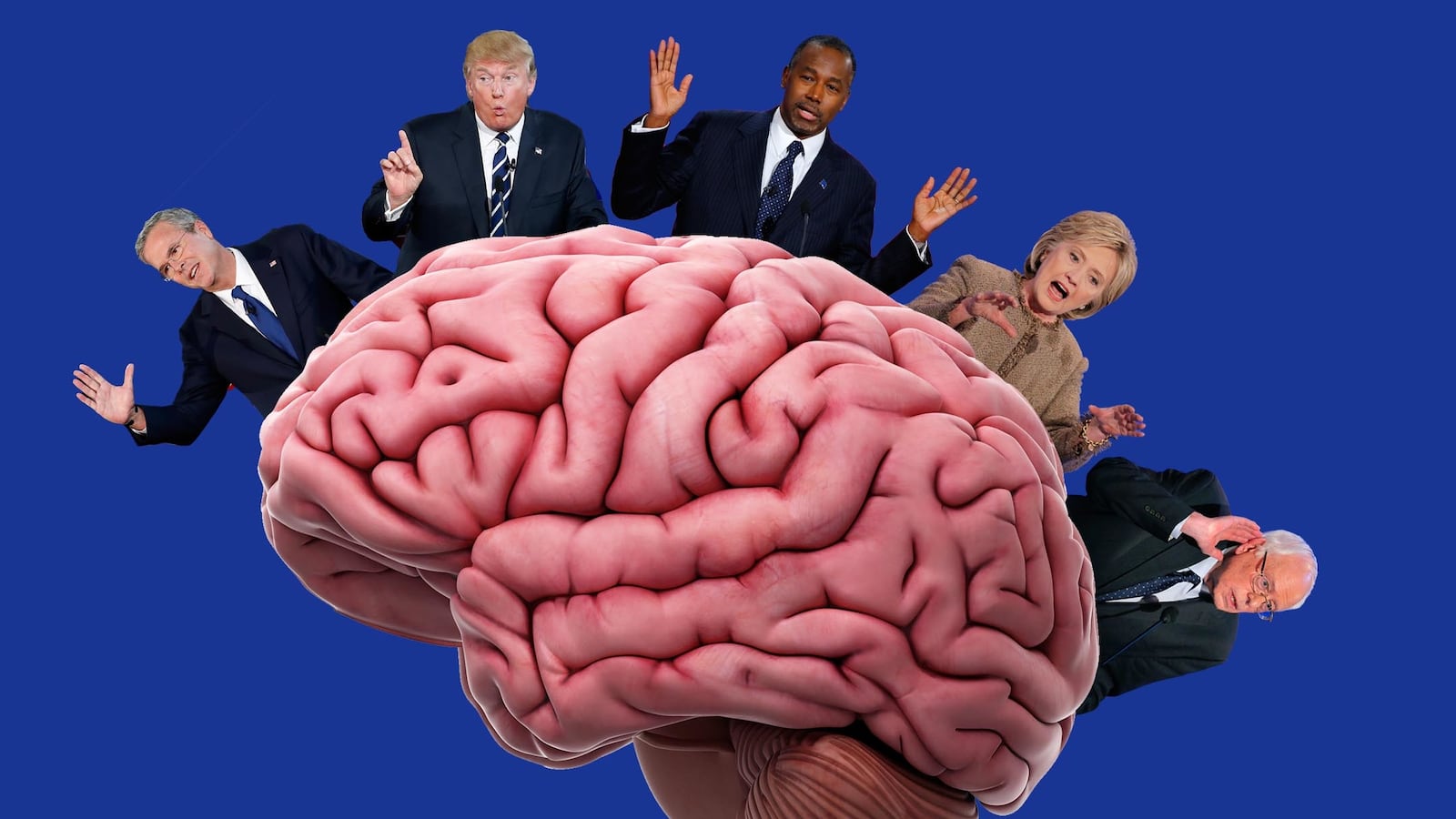Bloodthirsty rage appears to have swept up the American people, like mass hysteria boiling up in an angry mob. Discussions of deadly violence have become central to this presidential election season, with calls for killing in political ads and debates not just the ravings of a single fringe candidate. Gone are the intellectual arguments that have dominated our presidential debates for two centuries—this time it is the brain’s limbic system “fear center,” not the cerebral cortex, that candidates are tapping to drive public discourse.
The word “kill” was said 53 times in the Dec. 15, 2015, Republican presidential primary debate. Here’s a sampling. Ted Cruz: “… we will hunt down and kill the terrorists.” Donald Trump: “These are people that want to kill us…” Trump also advocates killing family members of ISIS terrorists. Lindsay Graham: “They’re trying to come here to kill us all…” Mike Huckabee: “We have to kill some terrorists and kill every one of them….”
By contrast, the word “kill” was never used in the 1960 Nixon-Kennedy presidential debate, despite the era’s dire threat of global nuclear annihilation. The “K” word was not spoken by any of 2000’s Republican candidates—George W. Bush, Alan Keys, or John McCain—in their final debate on March 2 of that year; nor was it uttered in the Jan. 30, 2008, final GOP debate among candidates Huckabee, McCain, Ron Paul, and Mitt Romney.
Clearly, these urgent calls for killing are a reaction to the widespread fear of terrorism gripping our nation. But when we operate out of fear, we are prone to making mistakes. This is not a matter of policy—it’s physiology. Republican or Democrat, hawk or dove, how our brain responds at times of perceived danger and how our cognitive function and behavioral reactions are overwhelmed by fear must be fully recognized.
The U.S. has faced frightening dangers during every election season. Why do we find ourselves in a panic this time?
In this election, fear does not arise from a rational deduction of potential dangers—it is primal. Back in the Cold War era, there was little anyone faced with impending thermonuclear armageddon could do, other than freeze in fear or flee. Hiding in bomb shelters was how fear moved 1960’s electorate. Today, the terror is coming to us personally—a maniac with a shotgun blasting into our schools, lurking in our shopping malls, invading the corridors of our office buildings with a gun barrel pointed at us. This fear of a personal confrontation with a killer strikes deep within us. It’s also the leading scenario of terrifying recurrent nightmares, according to a 2015 study.
A peek inside the brain can help us understand how the unusual intersection between political science and neuroscience is driving this election. The biological reflex for violent aggression does not reside in the cerebral cortex, where consciousness arises. The circuitry for threat detection, fear, and violence is centered deep in the brain in what scientists call the hypothalamic attack area. Excluding mental illness or criminality, only a few specific provocations will trigger the rage circuit in our brain to launch us into violent action. The most obvious one: self-defense. The bombing of Pearl Harbor and the destruction of the World Trade Center provoked an immediate strong commitment of men and women to join the armed forces. There is not space to trace out the nine triggers of rage here; however, the arguments in the Republican debates and campaign ads press forcefully on eight of them. No wonder there is so much talk of killing.
History shows that political leaders can exploit the brain’s triggers of rage to incite the populace to engage in violence and war. The Vietnam War was launched on a false pretext U.S. Navy destroyers were attacked by the North Vietnamese on Aug. 4, 1964. Colin Powell waved a mock vial of anthrax in the United Nations to persuade “a coalition of the willing” to invade Iraq to eliminate weapons of mass destruction that posed an imminent threat to the United States. “I deeply regret that the information—some of the information, not all of it—was wrong,” Powell said in 2011, looking back on his role in launching the Iraq War. Some historians have charged that President Franklin D. Roosevelt ignored the flotilla of Japanese warships steaming toward Pearl Harbor so that their sneak attack would enrage the American public and incite a declaration of war. The merit in this charge is less important than recognizing that exploiting the brain’s trigger for self-defense will incite violent rage in the minds of people, and overlooking a battle group in the Pacific is much harder to do than overlooking terrorist chatter on the Internet.
We seem caught up in a frenzy of mass hysteria and fear inflamed by violent rhetoric. Fifty-five Americans died in Afghanistan in 2015; 6,830 U.S. service members and their Western allies have been killed in Iraq and Afghanistan since 2001. These statistics reflect a horrible loss of life and courageous self-sacrifice, but to assess the current level of fear, these casualties must be put into historical perspective with other dreadful terrors this nation has faced: the 750,000 lives lost in the Civil War, and the 6 million Jews killed in World War II.
Chronic stress puts the brain on a heightened state of alert in which we are much more likely to snap violently—to override rational thought and unleash violence in response to slight provocations. Our nation has suffered from chronic stress since the 9/11 terror attacks. This prolonged stress makes us jumpy and prone to “shoot first and ask questions later.”
Another physiological consequence of this fear and fixation on catching “the bad guy” is tunnel vision. A retired D.C. cop broke into a cold sweat telling me of an adrenaline-charged pursuit of a suspect fleeing at more than 100 miles per hour on Interstate 95. The officer eventually forced the vehicle off the highway and took the driver into custody. “What about the other guy?” he was asked when his backup officers finally arrived. Fixated on the driver, he never saw the passenger still sitting there with a loaded .45-caliber handgun in his lap.
In the 14 years since al Qaeda carried out attacks on New York and the Pentagon, extremists have killed 74 people in domestic terrorism in the United States; of those, the majority, 48 victims, were killed by non-Muslim extremists. The biggest threat in domestic terrorism comes from internal antigovernment extremists (74 percent).
The terror of 9/11, the massacres in Paris, the bombs at the marathon in Boston, are horrific, but what about the catastrophic danger of North Korea threatening thermonuclear attack? What about the Soviet Union and China exercising their growing military muscle, probing other nation’s borders and threatening war? There seem to be no lack of issues or dangers pressing on this country, but the hysteria of tracking down and killing Muslim extremists blinds us to all else.
Verbal threats are in themselves a form of violence, and threats are especially dangerous in large groups of people, be they mobs, gangs, or nations. Threats to set the sands glowing with carpet bombs (quoting Ted Cruz) trigger violent rage in those who are threatened. Drawing a line in the sand and vowing to shoot down a Russian jet that crosses it (as Christie vowed) is a street-thug challenge that risks war in which both sides would feel righteously justified in killing. The substance of these positions can be discussed without resorting to threats of death, but attempts to temper public discourse are being quashed. “And political correctness is killing people,” as Cruz says. From the Gabrielle Giffords shooting to the slaughter at the Planned Parenthood clinic in Colorado, the tragic effects of violent rhetoric on unstable individuals and extremists is inescapable.
“Light the motherfucker on fire!” a Trump supporter screamed at a protester who was being forcibly removed from a recent Trump rally. “Shoot him! Kick his ass!” raucous Trump supporters screamed at another demonstrator.
Urgent public calls for killing are as dangerous and irresponsible as screaming “fire” in a crowded movie theater.
The human brain is not a slave to its fear circuit. “Fear is a force that sharpens your senses,” writes Navy SEAL Marcus Luttrell, the only surviving member of a horrendous Taliban ambush described in his book Lone Survivor. Inhibition of the brain’s threat-response circuitry by the cerebral cortex is what enables a U.S. Marine or Navy SEAL to operate effectively in battle and to triumph—to use fear—not be paralyzed by it, despite the most intense fear of death imaginable.
In this election, more care must be given to the biological triggers of rage in the human brain. Fear itself can be our biggest threat. Civil discourse engages the rational cerebral cortex—not the emotional fear and threat-detection circuits of the limbic system. Let’s demand “trigger locks” on violent rhetoric. In acting together in public discourse or alone when we enter the voting booth, we should use the most astonishing bit of matter the Earth has ever known: the human cerebral cortex and not the limbic system.






